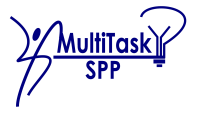Unraveling crosstalk from lower-level motor coordination to higher-levels in the cognitive-behavioral hierarchy (2018-2021)
Team
Prof. Dr. Rouwen Cañal- Bruland Principal Investigator | Prof. Dr. Oliver Herbort Principal Investigator | ||
| | Eric Grießbach PhD Candidate |  | Philipp Raßbach PhD Candidate |
Former team members
Francesca Incagli
PhD Candidate |
|
Abstract (2018-2021)
Complex commonplace tasks, such as driving a car or playing soccer, are thought to be organized hierarchically. Hierachical organisation refers to the idea that overarching higher-level decisions (e.g., deciding which route to take with the car) govern the functioning of processes coordinated at lower levels of the hierarchy (e.g., steering the car). Notably, decisions on higher-levels of the behavioral hierarchy often have to be made while simultaneously coordinating lower-level motor processes, dubbed as multitasking. Whereas cognitive models of the hierarchical control of behavior assume that processing at different levels of the hierarchy is more or less independent, research on multitasking, embodiment, and ideomotor theory suggests that not only do higher-level decisions determine lower-level processing but that crosstalk stemming from lower-level processing also affects higher-level decision making. However, this type of crosstalk is under-researched as the literature on multitasking predominantly focusses on the coordination of independent rather than hierarchically nested tasks and because models on hierarchically organized behavior typically assume independence of the involved processes.
Therefore, the aim of the proposed project is to scrutinize to what degree higher-level (cognitive) decisions are affected by the ongoing coordination of lower-level (motor) actions that are necessary to implement the higher-level decisions. To this end, we follow and combine movement scientific and psychological approaches and paradigms to examine and identify the impact of three potential different crosstalk pathways from lower to higher levels of the hierarchy. Two tasks – a real-life walking task and a computer-based tracking task – will be employed that complement each other within the proposed project. Whereas the walking task enables us to examine crosstalk in a complex, ecologically valid situations, the computerized simpler tracking tasks allows for more fine-grained scrutiny of the phenomenon. Importantly, establishing and utilizing these two paradigms in conjunction is mandatory to finally address questions concerning transfer of crosstalk across different tasks, thereby allowing to speak to issues regarding the generalizability of the studied crosstalk phenomena.
In summary, bringing together expertise and paradigms from movement science and cognitive psychology, this project allows to generate knowledge about human multitasking and crosstalk from lower-level coordination to higher-levels in the cognitive-behavioral hierarchy that is both practically relevant to and applicable in a multitude of daily human behaviors.
Project Output
Grießbach, E., Incagli, F., Herbort, O. & Cañal-Bruland, R. (2021). Body dynamics of gait affect value-based decisions. Scientific Reports, 11, 11894.
